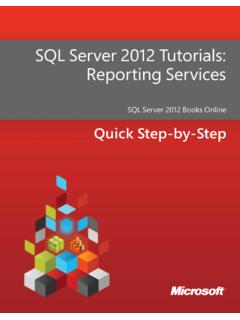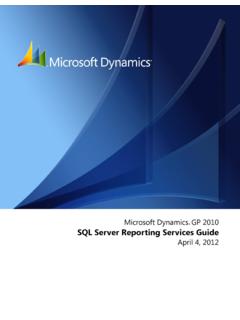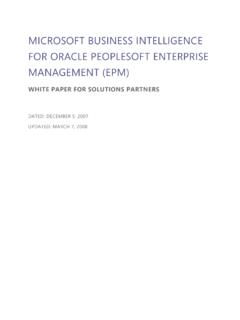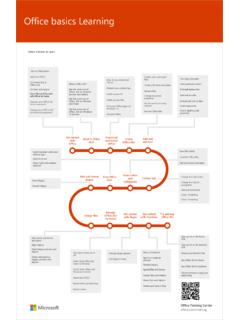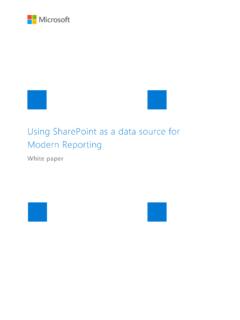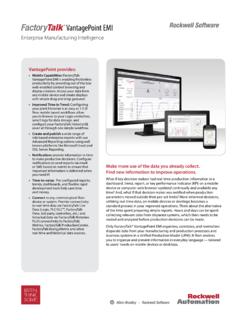Transcription of Data Warehouse Fast Track - download.microsoft.com
1 data Warehouse Fast Track Faster deployment Reference Guide for SQL server 2017. SQL Technical Article December 2017, Document version Reduced risk Authors Jamie Reding Henk van der Valk Ralph Kemperdick Contributors Sadashivan Krishnamurthy Value Sunil Agarwal Matt Goswell Flexibility and choice Contents Introduction .. 1. data Warehouse workload challenges .. 4. Database 5. Reference implementation .. 7. Choosing a DWFT reference configuration ..10. Example: Using the DWFT metrics to compare configurations ..10. DWFT best 11. Appendix A. DWFT Certification template with reference system data ..21. Appendix B. data Warehouse Fast Track 22. Appendix C. data Warehouse Fast Track query examples .. 23. Copyright 2017 microsoft Corporation. All rights reserved. This document is provided "as-is." Information and views expressed in this document, including URL and other Internet Web site references, may change without notice.
2 You bear the risk of using it. Some examples are for illustration only and are fictitious. No real association is intended or inferred. This document does not provide you with any legal rights to any intellectual property in any microsoft product. You may copy and use this document for your internal, reference purposes. data Warehouse Fast Track Reference Guide for SQL server 2017. This paper defines a reference architecture model known as data Summary Warehouse Fast Track , which uses a resource-balanced approach to implement a symmetric multiprocessor (SMP) based SQL server database system architecture with proven performance and scalability for data Warehouse workloads. The goal of a data Warehouse Fast Track (DWFT) reference architecture is to help enterprises achieve an efficient resource balance between SQL. server data processing capability and realized component hardware throughput.
3 Despite advances using in-memory technologies and the advent of solid-state drives (SSDs), storage I/O remains the slowest operation in a computing environment. The DWFT reference architecture compensates by offloading performance onto the storage subsystem to deliver a balance that works for data Warehouse operations. As a result, enterprises can deploy a data Warehouse with SQL server that is optimized for data Warehouse operations. Enterprises can then also take advantage of additional SQL server capabilities, which are also referenced in this document. data Warehouse Fast Track Reference Guide for SQL server 2017 1. Introduction Increasingly, enterprises realize that appropriate use of compute and storage resources can help them more successfully work with today's demanding data -driven solutions. With the rapid shift to memory- centric computing, the ability to balance performance between in- memory search algorithms and disk I/O is more important than ever.
4 The SQL server data Warehouse Fast Track (DWFT) program is designed to provide customers with standard and proven system architectures optimized for a range of enterprise data warehousing needs. DWFT is a joint effort between microsoft and hardware partners. The goal is to help enterprise customers deploy data Warehouse solutions with a recommended hardware configuration appropriate for the requirements of the workload with reduced risk, cost, and complexity. Enterprises can purchase and build on reference implementations from participating system vendors or leverage the best practice guide provided through the program. The DWFT reference architecture program is continuously being improved to incorporate new SQL server features and customer feedback. This document is for IT planners, architects, database administrators, and business intelligence (BI) users interested in standard, proven system architectures for DWFT-conforming SQL server workloads running on-premises or in Azure.
5 This document defines DWFT component architecture and methodology. The result is a set of SQL server database system architectures and configurations including software and hardware required to achieve and maintain a set of baseline performance levels out-of-box for a range of data warehousing workloads. When enterprises use the DWFT program to set up a data Warehouse built on SQL server , they lay the foundation for a complete data Management Platform for Analytics. They can then take advantage of newer SQL server features, including in-memory columnstore technologies that improve the performance of transactional and analytics workloads, as well as the ability of SQL server to run on either Windows or Linux. They also gain support for both traditional structured relational data and for unstructured big data , such as Internet of Things (IoT) data stored in Hadoop, Spark, or an Azure data Lake, all the while being able to query the data in languages such as T-SQL, Java, C/C++, C# , PHP, , Python and Ruby.
6 data Warehouse Fast Track Reference Guide for SQL server 2017 1. DWFT in-memory By using PolyBase, a feature in SQL server optimized for data Warehouse compression workloads, enterprise customers can also merge big data into the SQL. enhancements available in server universe. PolyBase provides the ability to query both relational SQL server data and unstructured data , joining it together into a single result set without moving the data . The ability to connect disparate data sources New hardware makes it more that straddle on-premises and cloud means cost-effective, business- affordable to run SQL server in changing solutions are now possible. memory, taking advantage of performance enhancements SQL server and its microsoft Azure counterpart, Azure SQL Database, are from memory-optimized tables part of a paradigm shift in the world of analytics.
7 Traditionally, data was and high in-memory data delivered to analytics routines and it was difficult to bring huge datasets compression of columnstore to data scientists for analysis. Today, with Azure Machine Learning technology. Studio, analytics are brought to the data . The ability to extract The data Warehouse Fast meaningful and actionable information from huge volumes of data Track program, which uses results in more powerful operationalization of analytics models in randomly generated data for applications and enables more companies to make sense of big data testing, shows 1 data assets. compression. This ratio is what you can expect with randomly As with any database system, the physical I/O speed of the storage generated data , rowstore to subsystem is typically the slowest performance component, even for columnstore. servers using high-performance SSDs.
8 For those reference architectures which rely on operational storage subsystems, if the storage subsystem In the field, however, you can isn't optimized, SQL server cannot perform well. The DWFT reference expect better: The architecture offloads performance onto the storage subsystem by compression ratio with real customer data is likely to be constraining memory use, which helps ensure a good starting point for closer to a 1:10 or even a 1:20 conventional operations. Anticipated in the near future will be reference ratio. This means that 1 TB of architectures which rely on Persistent Memory, systems configured to uncompressed data , mapped use high speed memory as disks, nearly eliminating the need to use the into clustered columnstore storage subsystem in normal operations. tables, would consume approximately 50 to 100 GB. After the system is in place, customers can modify, expand, and Typical query response time extend as needed, adding more memory, more storage, and from in-memory columnstore more processing power as they begin to use the apps that are data would be measured in included with SQL server including SQL server Analysis milliseconds, rather than Services, SQL server Integration Services, SQL server Reporting minutes or even hours.
9 Services, and Master data Services. Enterprises can make further adjustments. Increasing the RAM on the server increases the amount of data that can be stored in memory, which takes the pressure off the storage subsystem. More RAM means more in-memory capability and more capability for hybrid transaction/analytical processing (HTAP), also known as real-time operational analytics. Memory access speed also increases as RAM sizes grow. At the far end of this spectrum, Persistent Memory systems keep all the data in memory at all times, writing to the storage only for backups and in case the system loses power. Thus, enterprises can deploy a data Warehouse with SQL server that is validated to DWFT program standards and sets them up to take data Warehouse Fast Track Reference Guide for SQL server 2017 2. advantage of additional microsoft data Management Platform capabilities, including Azure Analysis Services.
10 data Warehouse Fast Track program The DWFT program identifies component hardware configurations that conform to the principles of the DWFT reference architecture. Each reference architecture configuration is defined by a workload and a core set of configuration, validation, and database best practices. The following are key principles of the Fast Track program: Workload-specific benchmarks. System design and configuration are based on real concurrent query workloads. Detailed and validated hardware component specifications. Component architecture balance between database capability and key hardware resources. The goal of this program is to achieve an efficient out-of-the-box balance between SQL server data processing capability and hardware component resources. Ideally, the configuration will include minimum system hardware to satisfy storage and performance requirements for a data warehousing workload.
